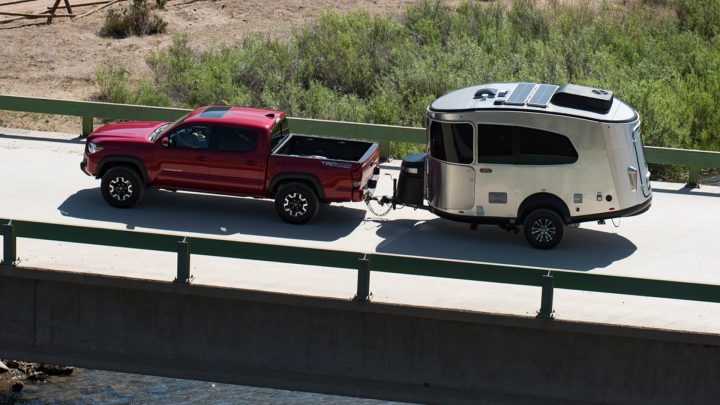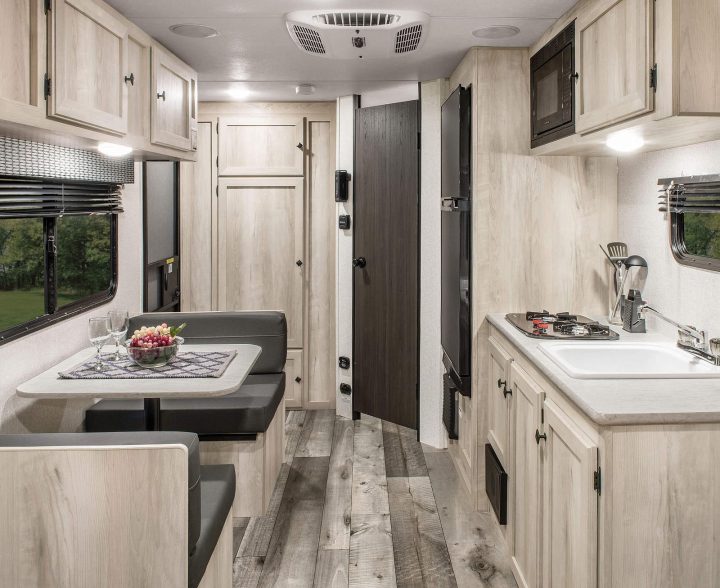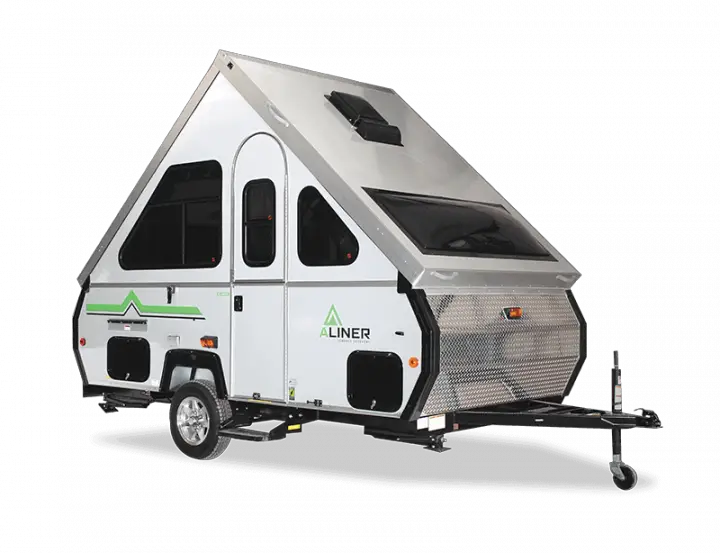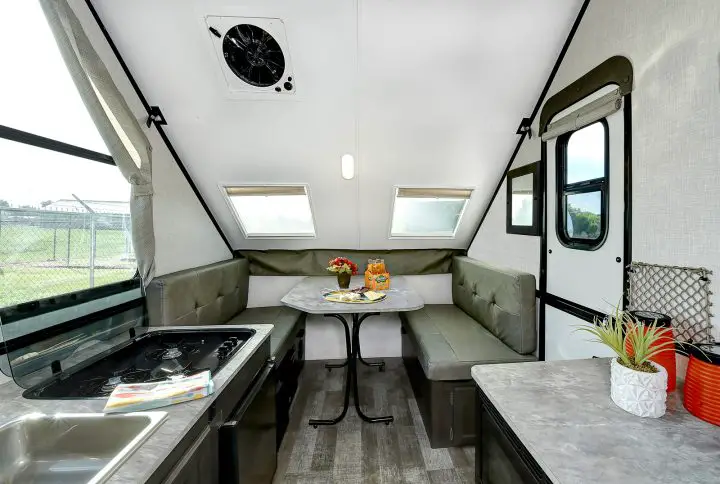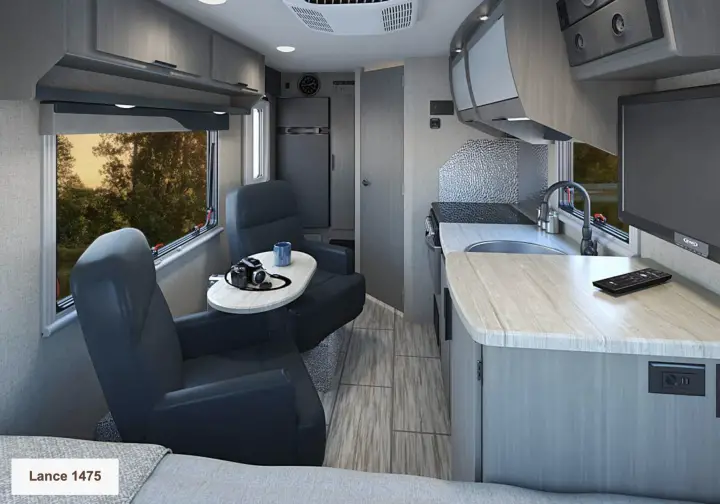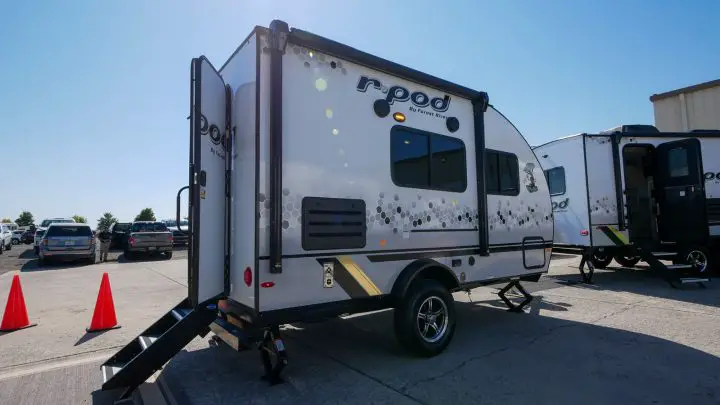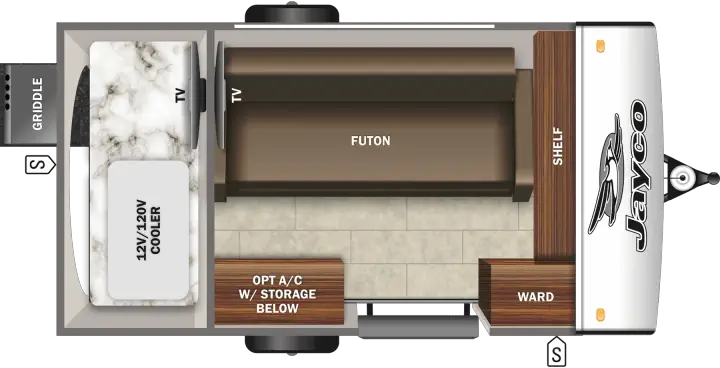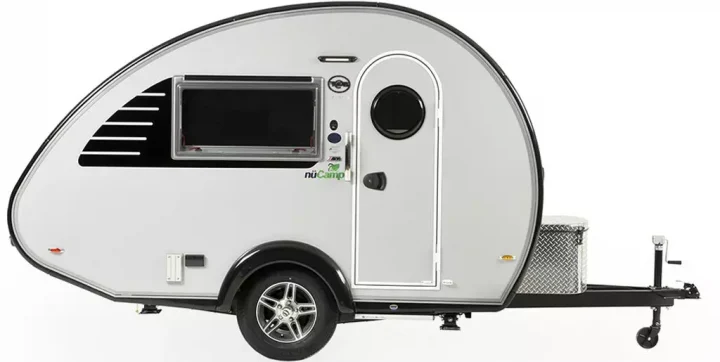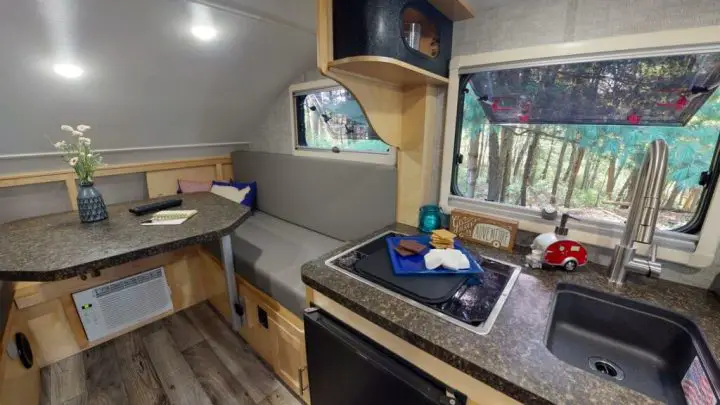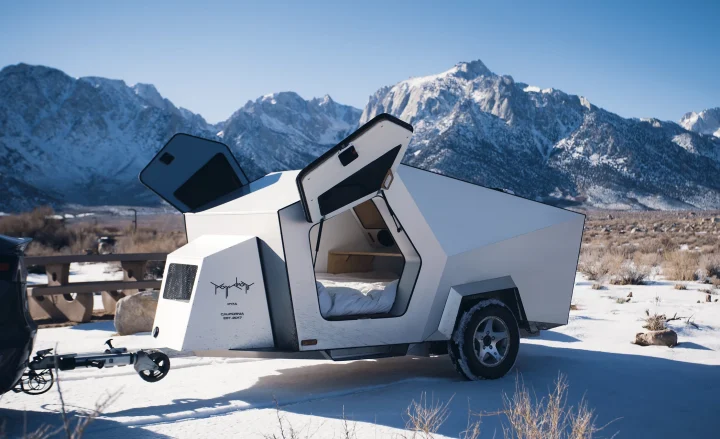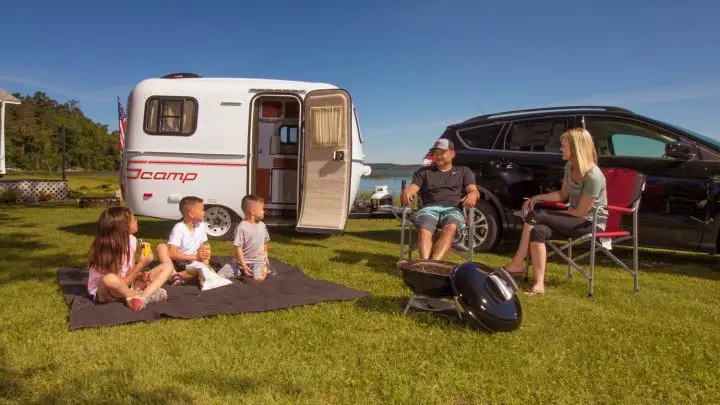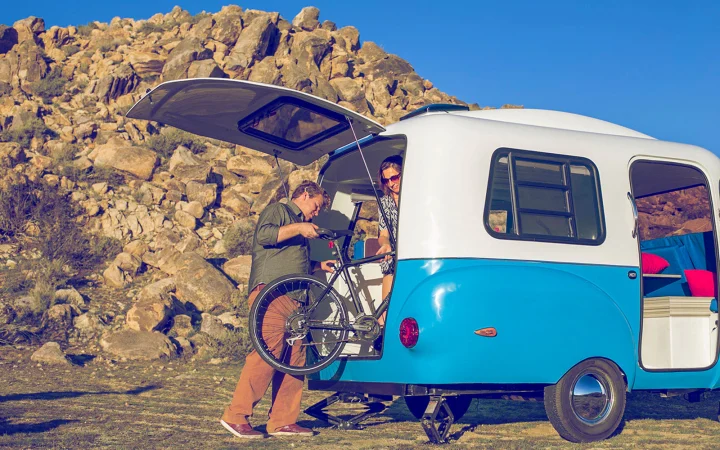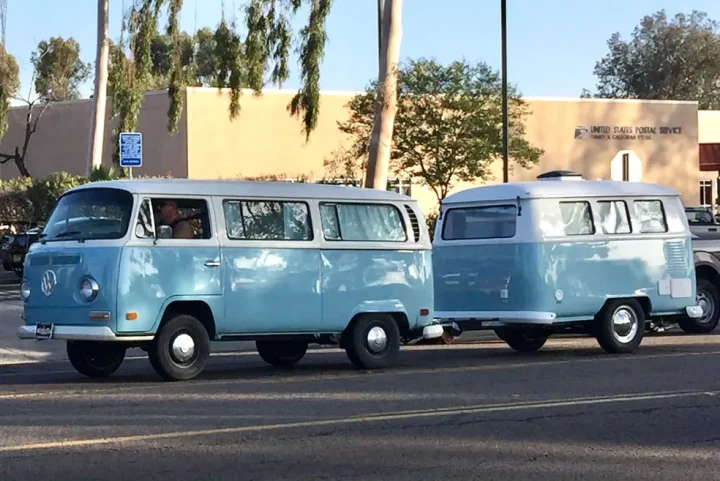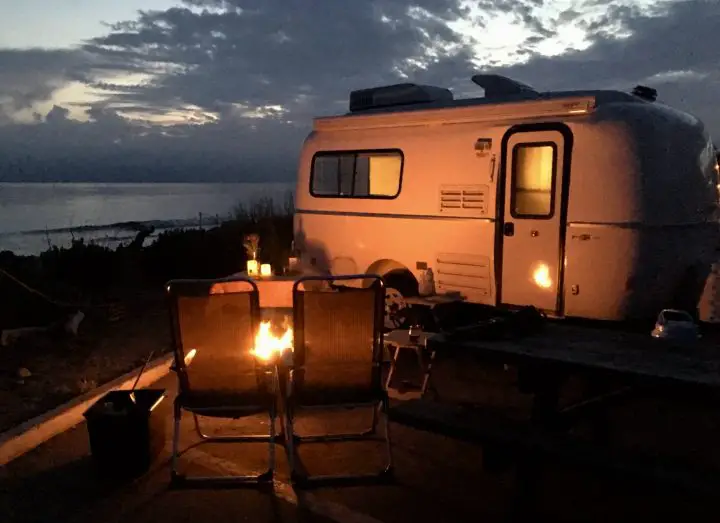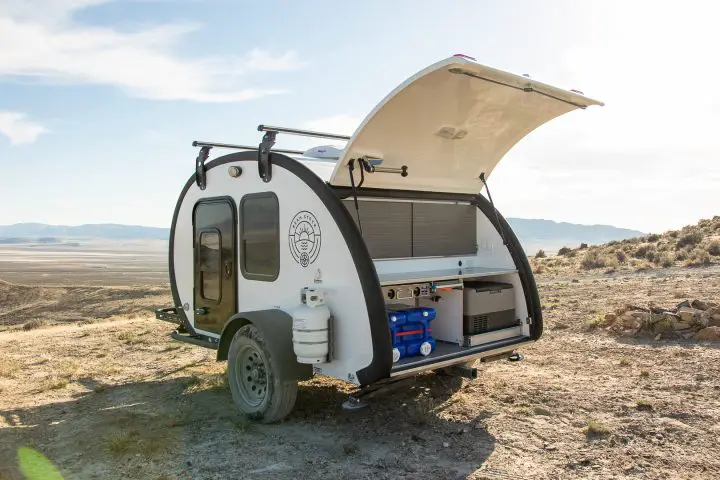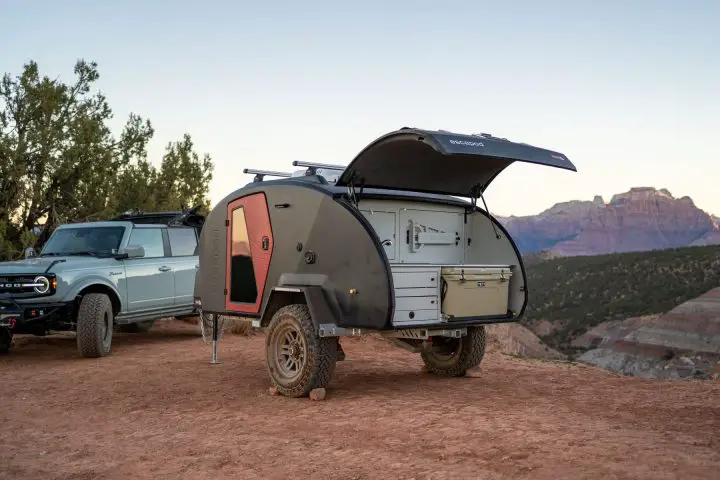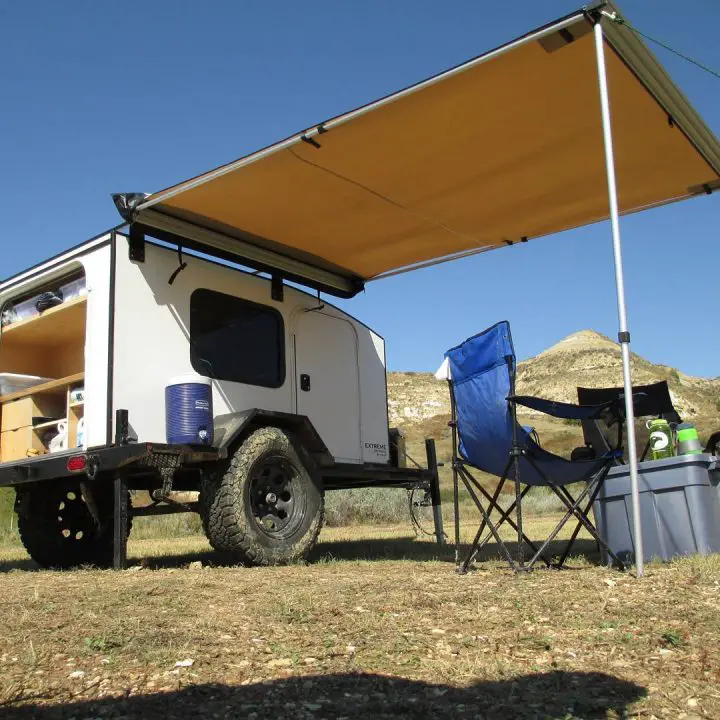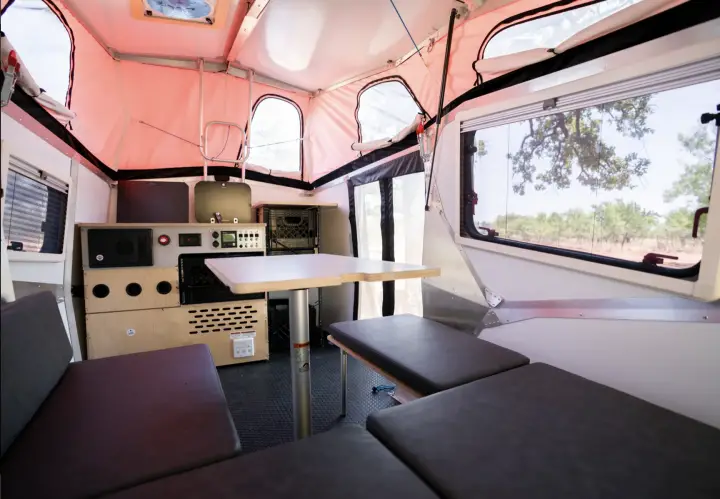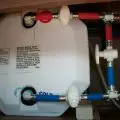Hey! This site is reader-supported and we earn commissions if you purchase products from retailers after clicking on a link from our site.
The pandemic and resulting boom in the RV industry has resulted in a lot of interest in the best small travel trailers. A light weight travel trailer is an ideal choice for many people. They are cheaper to purchase and own than van life Class B campers and more accessible than Class A or Class C motor homes. Many can be towed with the cars and SUVs we already own, making them a win-win. You can explore the world and live the Instagram life, all while traveling on your terms.
In truth, these lightweight camping trailers have been around for a while. They’ve always enjoyed a small niche corner of the RV market. So you might be surprised by the choices available when looking for an RV under 3500 lbs. You’ll find everything from diminutive teardrops and micro campers to off-road overlanding adventure habitats.
Here’s a look at the various things to look for in the best lightweight travel trailers out there, along with some of the best ultra-lite travel trailers on the market today.
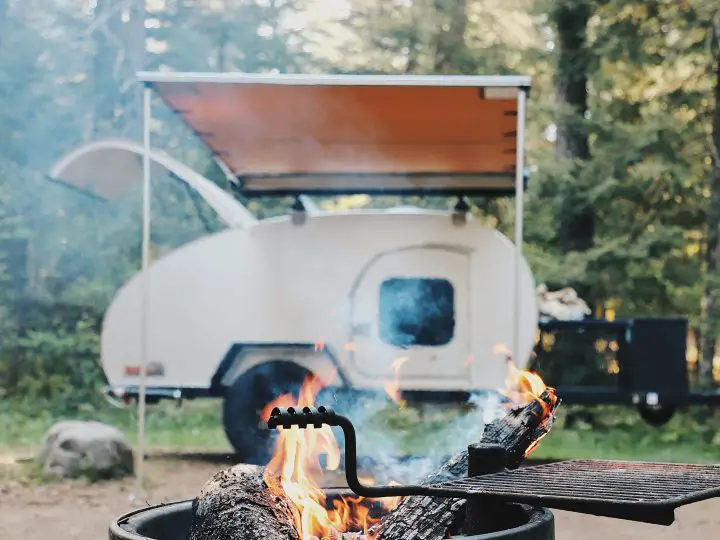
Table of Contents
- Best Ultra Lite Travel Trailers and RV Under 3500 lbs.
- What are Lightweight Travel Trailers?
- Why Choose Lightweight Camping Trailers?
- Types of Travel Trailers Under 3500 lbs
- Trailers Under 3500 lbs. – Features and Ownership Issues
- What’re the Best Lightweight Travel Trailers for Your Adventure?
- Lightest Travel Trailer FAQs
Best Ultra Lite Travel Trailers and RV Under 3500 lbs.
Best Small Travel Trailers – Traditional RV Styles
Airstream Basecamp 16 – One of the Best Lightweight Travel Trailers on the Market
Estimated Empty Weight 2,650 lbs. (Based on GVWR 3,500 lbs.)
One of the most eye-catching and stylish lightweight travel trailers on the market is the tiny Airstream Basecamp. It’s available in 16 and 20-foot lengths, each one retaining signature Airstream styling but with a modern aesthetic. The curved aluminum-skinned exterior includes wrap-around windows and the amenities you’d expect from a high-end manufacturer like Airstream.
The layout of the Basecamp is very similar to other sub-20-foot trailers. There is a walk-through dinette in the rear that converts into a double bunk. Mid-layout, there is an enclosed wet bathroom. In the front of this lightweight travel trailer, there is a u-shaped kitchen with a sink, double-burner stovetop, and small fridge.
The Airstream has entry doors at the rear and on the side. The available Basecamp X upgrade includes off-road upgrades and air conditioning.
KZ Sportsman 130RB and 160QB – Traditional Small RV Trailer with Queen-Sized Sleeping Space
Empty Weights Start at 2,240 lbs.
KZ makes very traditional aluminum-sided RV travel trailers. Their 13-foot model (16-foot 9-inch overall) is designed to sleep two adults and starts well under the 3,500-pound mark. In fact, all of their Sportsman Classic floorplans have unloaded vehicle weights under 3,500 pounds–even the 191BHK with a slide-out dinette.
If your vehicle can tow it, the best balance is undoubtedly the 160QB (QB as in “queen bed”). This model is one of the best lightweight travel trailers and it ditches the all-too-common convertible dinette in favor of a walk-around bed located upfront. The dinette and kitchen are small but completely adequate for a couple. In the rear, there’s an enclosed bathroom with a separate shower. The amount of amenities they’ve squeezed into this sub-3,000 pound travel trailer is incredible.
Aliner Classic
Empty Weight 1,725 lbs.
Aliner makes several sizes of their hard-sided a-frame pop-up, but the original Classic remains the perfect combination of size, weight, and price. It is one of their medium-sized campers, built in a 12-foot box on a 15-foot-long frame.
The a-frame pop-up provides lots of headroom in the cabin’s center, where you might stand up to use the kitchen or sink. The front and back are dedicated to the dinette and large bed. The dinette converts into a bunk if you have guests over. The Classic does not have a toilet.
Alternatively, the LXE model includes a dormer pop-up on the forward end, extending standing headroom and moving the kitchen forward. There’s also an enclosed shower with a cassette toilet in this area. But getting this travel trailer means giving up the dedicated bunk and dealing with a convertible dinette instead. The weight difference between the two is negligible; the LXE is only 70 pounds heavier than the Classic.
Forest River Rockwood Hard Side Pop-Up
Empty Weight Starting at 2,120 lbs.
Rockwood by Forest River RV makes some a-frame pop-ups like Aliner, but they are a little heavier and come with a few more features. Rockwood also makes traditional tent-style pop-ups. Like Aliner, they have several models of lightweight travel trailers, some with dormers for more headroom and some with full-sized queen bunks. All of their a-frames have unloaded dry weights between 2,120 and 2,648 pounds. They are built in either 12 or 14-foot long boxes.
Lance 1475
Empty Weights Starting at 2,750 lbs.
The Lance 1475 camper could easily count as a lightweight travel trailer if you load it carefully and watch your installed options. If your vehicle is sturdy enough to tow 3,500 pounds reliably, this is one of the nicest appointed trailers. The cabin is only 14 feet, with an overall trailer length of 19-feet 8-inches. The total GVWR for the trailer is 3,700 pounds.
The Lance features a layout that boasts features you are unlikely to find in any other travel trailer of this size. Forward you’ll find a queen-sized bunk. In the center, there is a full-featured kitchenette opposite a small dinette or captain’s lounge chairs. In the back, an enclosed shower and bathroom round out this home away from home.
With all the living space, it’s easy to forget all the other standard amenities you get with this package. For example, air conditioning and ducted heat also come standard.
Forest River R-Pod – Loaded with Standard Features
Empty Weights Starting at 3,159 lbs.
Forest River R-Pods are traditional RVs made with a slightly more aerodynamic design. They’re large and heavy when compared to many lightweight trailers, but they offer a more conventional RV experience. The interior features a U shaped dinette that converts into a double bed, a rear bath, and large windows throughout that contribute to a spacious atmosphere.
The smallest R-Pod is the RP-153, which is 17.5 feet long overall. There are multiple layouts and options all the way up to the top-of-the-line RP-195, which features a queen size bed with lots of under bed storage.
Jay Feather Micro 12SRK
Empty Weights Starting at 1,585 lbs.
RV giant Jayco isn’t to be left out of the ultra-small camper fun. Their Feather Micro 12SRK is one of the smallest and lightest traditional travel trailers out there. It’s an interesting little trailer–while it looks like a diminutive travel trailer, it’s functionally more like a large teardrop.
You see, the 12SRK includes an exterior kitchenette. A 12-volt cooler and griddle are accessed from the rear of the trailer. Inside the small cabin, there is only a futon and some storage nooks.
Best Small Travel Trailer Teardrop Campers
NüCamp TAG and TAB RV Teardrops
Empty Weights Start at 1,269 lbs. (TAG); 1,946 lbs. (TAB 320S Model)
NüCamp makes two different size teardrop campers. The smaller TAG and TAG XL are classic small teardrops. There is no standing headroom in these small and easy-to-tow travel trailers, but there is a full-featured exterior kitchenette around the back. Inside, you’ll find a queen-sized bunk, ample storage, and a really cool stargazing window. Both the TAG and TAG XL are the same length, but the XL is one foot wider.
The TAB 320 is a larger travel trailer that retains the teardrop profile. This camper has standing headroom inside, with an enclosed wet bath and kitchenette forward and a convertible dinette in the rear. It’s a slick, useable layout packed into a very small package. It provides space to hang out when the weather stinks, or you just want to sit comfortably and gaze out the large side windows. But it easily swaps into a bed space each night.
Little Guy Teardrop
Empty Weights Starting at 1,785 lbs. (Micro Max Model)
This “Little Guy” is similar to the TAB 320–it’s a larger teardrop designed to give amenities that more closely resemble a larger trailer. Three lengths are available, from the smallest and lightest Micro Max at just under 16-feet long to the 21-foot-long Little Guy Max (GVWR 4,200 pounds).
If you’re looking for a basic and easier to tow teardrop and into an ultra lightweight travel trailer, you’ve got to check out the Little Guy MyPod. This 100-percent fiberglass teardrop is sleeker than any other on the road and has a dry weight of only 840 pounds. It also has a unique rear-door entry, which allows for an exterior tent to hook up to add living space. However, unlike other teardrops, it does not come with space for a kitchenette.
Polydrop – Space Age Teardrop with Style
Empty Weight Starting at 820 lbs.
The fact that the Polydrop’s promo photos show it being towed by a Tesla Model 3 is telling. If the Polydrop trailer looks like it came from outer space, that’s because it almost has. This compact travel trailer is a conventional teardrop that was beamed in from the 21st century. The company has studied the design in wind tunnels to get the shape just right, molded the interior to suit a modern aesthetic, and kitted it out with state-of-the-art lithium batteries and solar panels.
The upgraded model, the P17A All-Electric, comes with 260 watts of solar power, 2.4kWh of Lithium Iron Phosphate batteries, a 2,500-watt inverter, induction cooktop, and an electric air conditioner that works off the grid.
Fiberglass Eggs – Best Light Weight Travel Trailer Choices
Scamp 13 – Fiberglass Ultralight Trailers
Empty Weights Between 1,200 and 1,500 lbs.
The Scamp design has been around for a long time, originally built in Canada under the Boler name. That’s good news because there are some available on the used market. But like most of the small fiberglass campers you’ll find, these Scamps have a loyal fan club and values on used campers stay relatively high.
The Scamp comes in two versions–standard and deluxe. The only real difference between the two is the furnishings–the standard is basic, with fiberglass walls and minimal equipment. This not only keeps it less expensive but lighter for towing.
This lightweight travel trailer has a convertible dinette in the rear, a small kitchen area in the center, and the forward area comes as either bunk beds or as an enclosed toilet, shower, and closet. If you’re looking for a little more space, the Scamp is also available in a 16-foot extended version and a unique 19-foot-long fifth wheel.
Happier Camper – High Quality Lightweight Travel Trailers
Empty Weights – HC1 1,100 lbs.; HCT 1,800 lbs.
The Happier Camper has fantastically updated the fiberglass egg design. These beautiful little travel trailers have everything you’re looking for in a micro-camper–classic looks, robust and versatile designs, and adventure-ready features. The HC1 has a 10-foot cabin, while the HCT (Traveler) has a 14-foot cabin.
You cannot deny that one look at a Happier Camper will sell you on the concept. They’re modern yet retro, with two-tone paint schemes and an aerodynamic profile. There is also an off-road upgrade with larger tires and increased ground clearance.
The classic jalousie windows are of particular note in the design, which let plenty of airflow through but doesn’t allow rain in. The rear liftgate is also a welcome addition since it makes the living space easily flow outside.
The interior of this lightweight travel trailers is a cleverly-designed modular system that HC calls Adaptiv. It’s made of removable, rearrangeable, and interchangeable fiberglass 20-inch cubes. There are various cubes, including storage nooks, bench/beds, coolers, a toilet, and a kitchenette. You can rearrange your Happier Camper into any layout you like, customized for any adventure you like. You can also leave space for bikes or other gear, like your own little toy hauler. That’s something no other lightweight travel trailer this size offers.
Dub Box and Dinky Dub Retro Adventure Campers
Empty Weights Start at 2,300 lbs. and 1,100 lbs., respectively
If you have ever dreamed of setting off in a classic VW pop-top camper van, the Dub Box trailer will give you your chance. These new lightweight travel trailers, available in two sizes, mimic the looks of a classic Volkswagen microbus travel trailer perfectly. They include a crank-up pop-top to add standing headroom, a convertible dinette, and kitchenette options. Unfortunately, they don’t include an enclosed bathroom, but they do include a dedicated cabinet for a portapotty.
Check out this tour of this amazing little camper.
The Dinky Dub is only nine feet long, or 14-feet with the tongue. The regular Dub Box Adventure Camper is 12 feet long, 17 feet overall. The exterior shell is molded fiberglass for long life and easy maintenance. They are built in Oregon.
Casita Fiberglass Travel Trailers
Empty Weights Start at 2,210 lbs. (Standard Version)
The Texas-made Casita is very similar in appearance to the Scamp 16, with a slightly more modern design and more amenities. This fiberglass travel trailer has a two-shell design for extra protection from the elements and have been built since 1981. They are very similar to a smaller and lighter travel trailer – Oliver.
The Casita comes in standard and deluxe versions and has several layout choices. The shells are always the same, however–a 17-foot-long cabin. In most cases, the deluxe models sleep fewer people but include enclosed toilet and shower compartments.
Best Lightweight Travel Trailer Choices for Off-Road Adventures
Bean Trailer Fiberglass Off-Road Teardrops
Empty Weights Starting at 1,650 lbs. (Classic Bean Roadster)
Bean–could there be a better name for a teardrop manufacturer?–makes travel trailers that are between 14 and 16 feet long. They are kitted out for either regular camp use (Bean Stalk and Classic Bean) or for off-road overlanding (Mean, Meaner, and Black Beans).
Bean Travel Trailers are configurable in every detail, perfect for a travel trailer this size. After all, every person who buys a Bean will likely be using it slightly differently.
Escapod TOPO and TOPO2 Off-Road Teardrops
Empty Weights TOPO 1,750 lbs.; TOPO2 1,500 lbs.
Escapod started by building an off-road capable teardrop, still available and called the TOPO. The original TOPO is a great lightweight travel trailer with nice specs–it has a wonderful kitchenette in the rear for camp cooking, an upscale interior with lots of storage and tech options, and a rugged but good-looking design that immediately feels at home off-road.
The TOPO2 is the camper that Escaped built after they learned all the off-road teardrop lessons they could. Thanks to a fiberglass shell and upgraded chassis, it’s lighter than the original. It’s got room for all the gear you want to take along and lots of little touches that make sure you know that real sportsmen built it in Utah. In short, it’s hard to find a cooler teardrop if you want to leave the pavement behind.
Hiker Trailers
Empty Weights 800 to 1,350 lbs.
Hiker Trailers are built in Indiana and Colorado, and they present a unique value for those looking for an overlanding lightweight travel trailer. These travel trailers aren’t fancy–they look more or less like small cargo trailers. But they are extremely lightweight, and they are inexpensive enough for most camping budgets.
Trailers are ranked in four different classes, from “highway deluxe” for regular campsite use to “extreme off-road.” These can go anywhere you can get the trailer to tow to. Upgrades to each model include beefier axles, better suspension, and better ground clearance. If you want a truly off-road trailer–not just one with bigger tires–then the Hiker off-road is hard to beat.
Each rated travel trailer can be spaced out on either a 5×8, 5×9, or 5×10 box. Prices start at just under $6,000 for a 5×8 Highway Deluxe.
Taxa Outdoors Habitats
Empty Weights Starting at 1,270 lbs. (Woolly Bear RTT model) or 1,800 lbs. (Cricket Pop-Top Camper)
Taxa Outdoors makes a few different versions of off-road friendly overlanding “habitats.” These are small, easy-to-tow trailers with varying levels of accommodations.
At one end, you have the Woolly Bear. This is basically a small but robust ultralight travel trailer built with a frame that supports a rooftop tent (RTT). The trailer’s slick drawers and storage compartments reveal a full exterior kitchenette, complete with a two-burner camp stove and Yeti cooler.
On the other end of Taxa’s lineup are the Tiger Moth, Cricket, and Mantis travel trailers. The Tigermoth is an updated take on the teardrop, while the Cricket and Mantis are low-profile and lightweight travel trailers that add headroom with a clever pop-top tent. Trailers are available in regular or upgraded overland configurations.
What are Lightweight Travel Trailers?
There are no travel trailers that you can truly tow with any car. So every trailer owner chooses–what is the biggest, most comfortable travel trailer you can tow with your vehicle?
Not everyone can afford to (or wants to) upgrade to a full-size pickup or a motor home. What’s more, many people are looking for a minimalist, simple camping experience. The point for them is not to have recliners and a big-screen TV–the point is to travel, to collect experiences and memories.
The folks interested in lightweight travel trailers are more likely to be younger couples. Some are occasionally camping throughout the year, and others stay in their campers for months.
From this description, it should be apparent that luxury is not the theme when you shop for an RV under 3,500 lbs. These travel trailers can be towed by many larger cars or mid-sized SUVs, but they will be smaller and more basic than other travel trailers, vans, or motor homes.
Lightweight RV Towing 101 – What to Tow With and What Not to Try
If you’re shopping for a lightweight travel trailer, chances are it is because you want to tow it with a small vehicle. Maybe that’s because you already own a car or SUV you’d like to keep, or maybe it’s because you don’t want to sacrifice your vehicle’s good gas mileage or comfort.
Every car and truck sold comes with a maximum recommended tow weight published by the manufacturer. The number varies depending on your country and how the manufacturer calculates the number. It is always best to stay within this safety limit. Doing otherwise could void your vehicle’s warranty. Worse still, if an accident resulted, you could be found at fault for overloading your tow vehicle.
Keep in mind that a car maker will rate the vehicle for towing based on many criteria. It’s not just the power available from the engine – it’s also the brakes’ quality and the transmission’s robustness, but also the towing bar you choose. Here are a few maximum towing ratings for new vehicles sold in the United States. This should provide some idea of the size trailer you could expect to tow.
| Vehicle | Manufacturer Rated Towing Capacity |
| Honda Accord sedan | 1,000 pounds |
| Hyundai Santa Fe crossover (base model) | 2,000 pounds |
| Jeep Wrangler (base model) | 2,000 – 2,500 pounds |
| Subaru Outback | 2,700 – 3,500 pounds |
| Tesla Model X electric SUV | 5,000 pounds |
| Nissan Pathfinder base SUV | 3,500 pounds |
| Toyota Tacoma pickup | 3,500 – 6,800 pounds |
| Ford Expedition SUV | 9,300 pounds |
| Chevy Suburban full-size SUV | 8,400 pounds |
| Ford F-250 pickup | 12,300 – 15,000 pounds |
| Dodge Ram 3500 pickup | 16,000 pounds |
Towing Weight Ratings Explained
GVWR (Gross Vehicle Weight Rating)
This is the maximum allowable weight for the travel trailer. It’s a designed-in limit, and the manufacturer is telling you not to load it heavier than this. The number includes everything on the rig – the frame, the cabin, all your stuff, appliances, batteries, and even water in the water tank.
What if your trailer has a GVWR of 3,500 pounds while your tow vehicle is only rated to tow 3,000 pounds? While some trailers are built right to the limit and use nearly all of their GVWR, others are not. Some trailers, especially those built to be lightweight from the start, may have a GVWR rating that allows carrying a bunch of gear. But since the cabin and appliances are light, much of that is available for your gear. As long as the actual tow weight is less than 3,000 pounds, you might be good to go.
GAWR (Gross Axle Weight Rating)
Each axle of the vehicle is rated to support only so much weight. This is how a trailer manufacturer comes up with the allowable GVWR.
Dry Weight, Empty Weight, or UVW (Unloaded Vehicle Weight)
This is the exact weight of your trailer, as weighed when it leaves the factory. As you can imagine, it varies with every trailer a company makes. Options like extra travel trailer batteries or better appliances will add to the weight.
It’s a hard number to pin down when shopping for a trailer. The trailer you come home with will have its own number, so you’ll only be getting rough estimates for what it will be before then. Any numbers you see online, including those used in this guide, are likely to be on the low end.
Net Carrying Capacity, or CCC (Cargo Carrying Capacity)
If you take your maximum allowable weight (GVWR) and subtract out the trailer’s dry empty weight, you are left with how much extra gear you can put in it. This is the net carrying capacity.
Tongue Weight
The tongue weight is important because it’s the weight that the rear of your tow vehicle must support. The heavier and sturdier your tow platform, the more tongue weight you can have.
A properly loaded trailer’s tongue weight is around 10 percent of its total weight. Any more than this could result in poor tow performance. Therefore, car and truck makers publish the maximum tow rating for the vehicle and the maximum tongue weight.
Actual Tow Weight
A number you would only know if you either do the math or weigh the trailer is the actual tow weight. If you know the trailer’s weight when it left the factory and the weights of everything you’ve added, you should have a solid idea of what the tow weight is.
This is the most critical number to know–because it is this number that you must apply to your vehicle’s tow rating. You’re good to go as long as this number is less than the car’s limit.
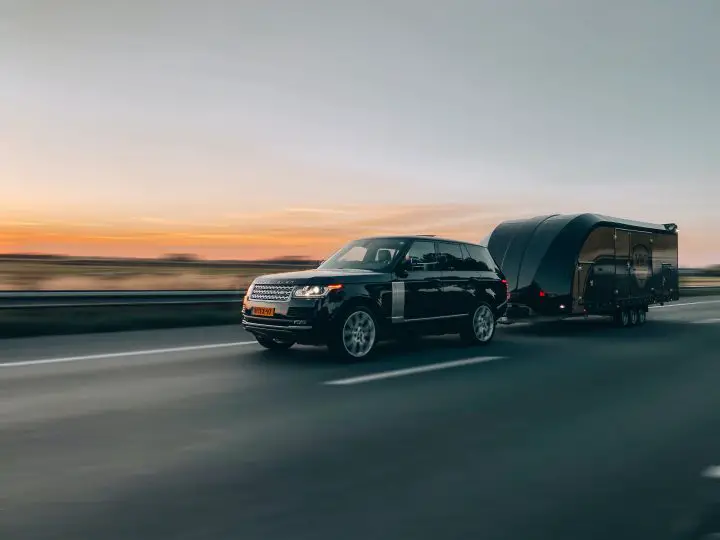
Why Choose Lightweight Camping Trailers?
Top Reasons to Purchase a Lightweight Travel Trailer Under 3,500 lbs.
For most folks shopping for light travel trailers, the appeal is that it’s better than a tent. If you have been camping in a tent for years and want a little bit of an upgrade–just a little more storage and more privacy – then a small travel trailer might be the answer.
What these tiny campers are not is an entry point into RV living. Most of the trailers under 3,500 lbs and 20 feet long will not provide the accommodations and living space you’re looking for. So if you’re shopping for a light travel trailer as an inexpensive way to get an RV with the car you already own, you might be disappointed by the results. If this sounds like you, consider a Class B or Class C motor home that doesn’t require a tow vehicle before downsizing into a minimal trailer.
Pros and Cons of Small Travel Trailers
Pros
- Can be towed with smaller, more fuel-efficient vehicles
- Cheaper to tow – requires less fuel no matter the vehicle
- Easier for boondocking and off-road use
- Lower purchase and upkeep costs
- More outdoor opportunities than larger RVs–exterior kitchens and rear hatches, for example
- Minimalist styling and living
- Can be stored inside a garage or storage shed
- Easy to add more storage and sleeping space if you already tent camp
Cons
- Less living space than larger RVs
- Less storage space for gear
- Less privacy than larger RVs have
- Weight limited – can carry less gear
- Fewer appliances and amenities
- Very small and simple kitchenettes
- Cramped bathrooms and showers (if it even has one!)
- Smaller beds or convertible dinettes
- Less insulation and all-weather potential than luxury RVs
Types of Travel Trailers Under 3500 lbs
Traditional Micro RVs
While being extremely weight-conscious, it is possible to find a traditional-looking and feeling travel trailer that fits the definition of “lightweight.” Don’t expect these campers to be as luxurious or as big as other choices–generally, we are talking about campers whose cabins are only 10 to 13 feet long. In that space, it’s possible to have a dinette that converts to a bunk, maybe an enclosed bathroom, and a small kitchen with a sink, tiny fridge, and maybe a single-burner stove.
It’s this type of RV that can easily get overweight. It’s very important to look at the GVWR for the trailer and exactly how much gear you’re going to be putting in it. Can your car really tow it? If you’re still car shopping, how much more towing capacity would you need?
Outside of specialized designs built for light towing, the RV industry hasn’t put much effort into small camper designs. The money comes from the big ones, and once they’ve convinced their customers that they need to buy a full-size truck to have a comfortable camper, there is little bonus for them to go back and work on lightweight designs.
However, many recent startups and a boom in the popularity of travel trailers have resulted in a little forward movement. The major trailer manufacturers are working on micro designs that are comfortable and noteworthy. One such example is the Airstream Basecamp.
Soft-Sided Pop-Ups
You can’t discuss lightweight travel trailers without mentioning pop-up campers. These hybrid tent campers are built like traditional trailers but lack walls. Instead, a robust tent with vinyl plastic windows and bug screens is installed on a frame.
Pop-up campers are an interesting concept, but they pose some problems. The experience isn’t very different from camping in a tent. The soft sides provide very little protection from the elements. They offer little privacy or shelter from cold weather or winds that hard-sided RVs do.
Another problem is that they tend to be on the heavy side. The travel trailer is low profile but still relatively heavy when folded down in towing mode.
It’s also worth noting that you can’t camp in soft-sided campers in some parts of the world. For example, in bear country, you need to keep your food, dishes, and kitchen area separate from your living and sleeping accommodations. These are all combined inside the same tent in a pop-up, making for a potentially dangerous combination.
Finally, remember that pop-ups are made of fabric and canvas, which will not last forever. New tents are expensive, so the resale value of soft side pop-ups decreases rapidly.
A-Frame Hard Side Pop-ups
A modern take on the pop-up camper is the pop-up a-frame. These campers use standard RV wall material that folds to make an A-shaped RV with standing headroom in the middle. It’s a unique take that solves many of the problems with a pop-up and retains the small trailer size and minimalist design.
Only a few companies make a-frames, most notably Aliner.
Classic Teardrop-Style Ultralights
Teardrops have a distinctive aerodynamic shape that makes them appeal to those towing behind a car. Their curved profile means less air resistance, but it also means less room to move around on the inside. Most teardrops are very small, and many even lack standing headroom.
These small teardrops nearly always share a similar layout. The interior cabin has a large padded bunk–and nothing else. Some have added shelves, and some even allow you to sit at a small table. The kitchen area is exterior and accessed through a lifting trunk on the back of the trailer. The inside of the camper is nothing more than an off-the-ground tent. All cooking, eating, and socialization are likely to happen outdoors behind the camper. Also note: most teardrops do not have a toilet at all.
There are also a group of teardrops that are slightly larger and have more amenities, like an enclosed bathroom and an interior kitchen. These are much larger and resemble the vintage “Canned Ham”-style trailers of the 1950s. They are comparable to a fiberglass egg-style camper, with a convertible dinette/bed, a small sink and fridge, and a cramped bathroom compartment.
There’s nothing too complicated about a classic teardrop trailer. Many people opt to save money by building their own, like CLC’s stitch-and-glue plywood teardrop or our very own DIY teardrop trailer.
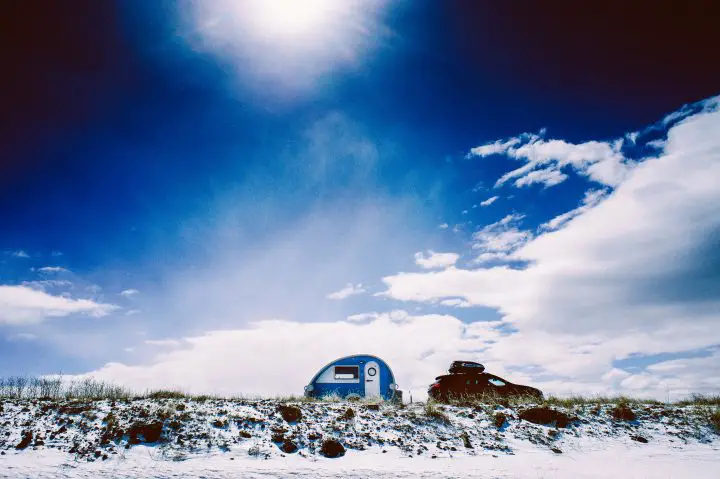
Fiberglass Egg Style
While many big RVs claim to be made from fiberglass, they are just made of pre-fab fiberglass paneling in the same method as an aluminum-sided RV. The fiberglass campers described here are completely different–they are laid up in molds, just like the hull of a boat. That means they can have complex curves and sleeker shapes than conventional RVs, but they do cost more to make.
However, they also last much longer and hold their value much better. Fiberglass eggs are some of the most popular micro-sized travel trailers out there. They’re cute as a button and very functional. And in many cases, they weigh far less than a conventional camper.
The epitome of the fiberglass egg is the Scamp. These 13-foot lightweight travel trailers come in several layouts and are light enough to be towed with most sedans and small SUVs.
Off-Road and Adventure Micro Campers
Overlanding and boondocking enthusiasts love the versatilities that a camper can offer. But they don’t want a bloated RV that requires a less-than-nimble tow vehicle. Instead, they need something compact, lightweight for towing, and agile enough to follow their truck anywhere.
What Features Provide Off-Road Capabilities?
High Ground Clearance
The number one thing that sets an overlanding trailer apart is its increased ground clearance. This isn’t just that the trailer is raised–it also applies to its overhangs. Many highway travel trailers have very low clearance and enormous overhangs to maximize the living space inside the cabin.
An overlanding trailer is more likely to offer minimal accommodations with smaller overhangs. This is one reason why teardrop trailers are perfect for the job–there’s no expectation of standing headroom inside, and the outdoor kitchen area means the rear can be kept well off the ground.
Stable, Low-Profile Design
Another important factor to consider is the trailer’s overall stability–how hard is it to tip over? While most four-season RV campers are top-heavy, an off-road trailer needs to remain upright at extreme angles should the terrain get sportier. This favors shorter designs, with more weight nearer the axle. The wider the trailer and axle, the better.
Oversized All-Terrain Tires
Knobbly off-road tires not only look cool, but they also get a better grip on difficult terrain and provide the traction needed to make it up inclines. They’re also less likely to get punctured accidentally on rocks and debris.
Rugged Chassis and Heavy Duty Suspension
All that bouncing along will take its toll quickly on a standard trailer chassis. Aluminum frames, often used on lightweight campers, are too weak to take the stress. Ideally, a galvanized steel frame is where it’s at.
Suspension on the trailer axle also deserves some consideration. The best offroad travel trailers have robust shocks and springs to help the trailer remain stable and tow well over any surface.
Off-the-Grid Capable
If you’re in the market for a lightweight travel trailer like this, you will want something that is just as comfortable away from hookups as it is with access to them. Most of these campers have battery systems with a small solar panel, a small quantity of freshwater stored in tanks, and not much else needed to have a good time.
Gear Hauling Options
Off-road travel trailers are adventure machines–so what adventure inspires you? Hunting, fishing, mountain biking, hiking, skiing/snowboarding, or fill in the blank here–your camper can take you there; just make sure it has storage space and options to carry your gear.
Modern Teardrops and Micro Campers
While the idea of a teardrop is not new, many companies are combining the idea of a modern fiberglass ultralight camper with the classic designs for a teardrop. This site is excellent for boondocking and adventuring offroad. Add on oversized all-terrain tires and a beefed-up chassis, and you’ve got yourself an adventure machine.
Trailer Tents
Another popular option for boondockers is the rooftop tent (RTT). But these tents are heavy–usually over 100 pounds–and pretty awkward to get on and off your car. Some companies have engineered small trailers that hold gear and an RTT. They can be towed by anything and can carry all sorts of gear.
You can apply this idea with some DIY skills to a classic Jeep trailer or even a $100 Harbor Freight utility trailer. RTTs aren’t cheap, but you can often find them used on Facebook Marketplace or Craigslist. Many also have enclosed annexes for showers, portapotties, or changing areas. When you combine this with awnings and the amenities built into the trailer, you have a great campsite ready-made to go anywhere.
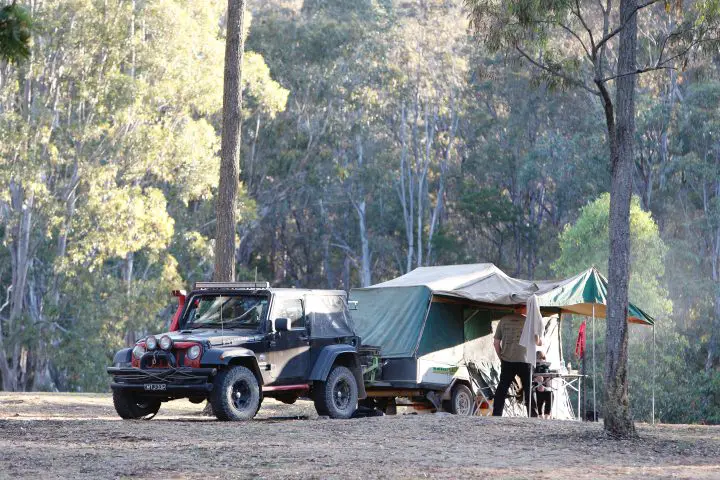
Trailers Under 3500 lbs. – Features and Ownership Issues
What Do You Get in a Small Travel Trailer?
Here’s a tour video of the Scamp 16, one of the larger campers you can get in this size range. It goes through the various layouts you can choose and gives you a great idea of what the space is like in one of these small lightweight travel trailers.
Owning a Small Camper
Owning a lightweight trailer isn’t much different from owning any other travel trailer, except that your overall ownership experience is easier and cheaper. These travel trailers are naturally less expensive than larger models that have more features. But with that plus comes another bonus–smaller trailers have less maintenance and fewer systems to keep working. All of this equals a lower cost of ownership in the long run.
Should You Buy an Extended Warranty?
Small campers are simple items with very little maintenance or warranty problems. You’ll have to look at the camper you choose and evaluate its construction and materials. It pays to scope out owners’ forums online, where you can connect with long-term owners and find out if they’ve experienced any problems. From these details and the cost, you can evaluate the true benefit of an extended warranty.
The only moving parts of a trailer are the wheels and axles. While these have a life span, most will never find it. The biggest danger to the longevity of a simple travel trailer comes from corrosion or rust on the axle and chassis frame. Always tend to any rust immediately to prevent further damage.
Materials
Traditional campers are made from paneled sides made from plywood, aluminum, or thin fiberglass sheets–or a combination of these things. They are framed together with wood or aluminum supports and generally hold up to the elements very well.
Alternatively, some modern travel trailers use all fiberglass construction. In this case, the camper shell is made in a mold, just like you would make the hull of a boat. This type of camper has a few benefits. They tend to be lightweight and long-lasting. They have more aerodynamic designs since the mold can produce complex curves. And they hold their value better than traditional travel trailers since they have very few maintenance requirements.
Upgrades
If you’re shopping in the used market, most upgrades will be simple additions you can DIY. Maybe you want to add better batteries, solar, or other off-road options.
When speccing out a new trailer from the manufacturer, you’ll likely be given many choices. Do you want air conditioning or heat? Do you want upgraded batteries and solar panels? Do you need that pressure water system, or is a jerry can good enough? Of course, all of these choices depend greatly on how you will ultimately use the trailer.
The only way to determine if an upgrade is valuable to you is to break out a spreadsheet and see how much it really costs. If you’re handy, chances are you can DIY most RV upgrades for less money than they would come from the factory. But, of course, if you’re financing it, it might make more sense just to spec the camper how you want it and make the monthly payment.
Finally, keep in mind that some things are harder or more expensive to add after the fact. If you want an overlanding lightweight travel trailer with extra ground clearance, sturdier suspension, and off-road tires, it’s best to buy this new. Otherwise, you’ll be buying the basic package and all the upgrades, too.
Common Problems With Travel Trailers
Generally, the smaller and simpler the camper, the fewer problems you will have. The more options and systems you add, the more complex the plumbing and the easier to stop up the drain, so to speak.
This logic applies to every system in the travel trailer. Simple teardrops usually have camp stoves and jerry cans for water. If that sounds like roughing it to you, you’ll want a built-in freshwater tank with fill and vent. Then, you’ll also need the hose and plumbing to run a 12-volt water pump. And, of course, you’ll need a 12-volt electric system to power that pump. A proper propane cooktop will require propane tanks and hoses, and the stove itself will cost four times as much as a good-quality camp stove.
Every RVer must strike a balance between how complex they want their travel trailer to be and how much time and money they’re willing to spend making it all work. These plumbing and electrical appliances add their complications and, of course, are all things that can and will break down and need replacing one day.
Running water and gas cooktops might sound complicated, but it sure is nice to turn the faucet and have running water. In your efforts to keep it simple, lightweight, and inexpensive, don’t undervalue the comforts of home.
What’re the Best Lightweight Travel Trailers for Your Adventure?
As you can see, there are a lot of choices out there. And thankfully, more lightweight camping trailers pop up on the market every year. There’s probably the perfect adventure camper ready for the mission, no matter where the road takes you.
Lightest Travel Trailer FAQs
What is the largest lightweight travel trailer?
Lightweight is a relative term with no official meaning in the RV industry, so defining the largest and lightest is impossible. Most people are limited by their tow vehicle’s capabilities. For this reason, this is where you form your definition of “lightweight.” To some extent, all campers are lightweight since they are designed to be towed by another vehicle.
For example, if you drive a two-ton pickup, you might be interested in a lighter camper to save a little gas money. A lighter camper also means you can tow a bigger camper and have more space and amenities. For you, a lightweight trailer is under 7,000 pounds and is around 25 feet long or more.
On the other hand, if you drive a newer crossover, you might be limited to 1,000 pounds. For you, an ultra lightweight trailer is your only option, and what that will mean is a tiny teardrop or a pop-up–and even that might be too much for your vehicle.
In other words, just because an RV manufacturer says their product is lightweight or ultra-lite does not mean that any vehicle can tow it. So always start with the rated tow weight your vehicle can handle, and then shop for the most trailer you can get under that weight.

